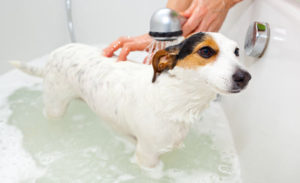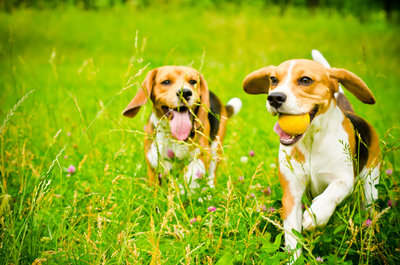Fleas are parasites that can live on your dog, bite his skin and suck his blood. They’re so small (less than 1/8 of an inch) that even spotting their presence can be difficult. However, presence of fleas can make your dog’s life miserable and can lead to infection. As a dog owner, it’s your job to protect your animal friend from these pests.
Flea Finding Techniques
There are many tricks to flea identification. Below are just a few:
- Use a white sheet. Lay your dog down on a white sheet. Use a flea comb to comb your dog’s fur, or use a hair dryer to blow your dog’s coat. As you do so, look for small black spots on the sheet. The black spots may be “flea dirt” (feces and dried blood) from your dog’s skin, or fleas themselves. Look for little spots of red on the sheet as well; this is likely blood that the fleas were feeding on.
- Inspect your dog. Use a flea comb to comb your dog’s fur near the base of the tail, the thighs and legs, the area around the ears, the stomach and neck. Look for signs of flea dirt on your dog’s skin. You may also see little black bugs crawling through your dog’s fur. Fleas are fast, so even if you don’t see a moving insect, this doesn’t mean that your dog is in the clear. If you find flea dirt, rub it off with a tissue. If it is actually flea dirt, some of it will appear red.
- Give your dog a bath. After the bath, inspect the bath water for tiny drowned bugs. Look carefully and in good light to help you spot the creatures.
- Watch for symptoms. Dogs infected with fleas itch a lot more than dogs who don’t. They may itch so much that their skin becomes red and raw, eventually developing sores. If your dog is infected with fleas, the itching will be concentrated on the area where the fleas are located, often the rump.
You Found Fleas…Now What?
If you do find fleas, give your dog a bath in flea shampoo and follow all instructions for application. At the same time, launder everything in your home that your dog comes into regular contact with that can go in the washer and dryer. This includes sheets, blankets, pillow cases, towels and more. Whenever possible, use hot water. For your carpet, upholstery and other items that can’t go in the wash, purchase flea powder and follow all manufacturer’s instructions for application.
Flea Prevention
There are a variety of ways that you can prevent your dog from getting fleas again in the future.
- Vacuum frequently and thoroughly.
- Keep your yard trim and clean.
- Give your dog flea shampoo treatment when you think your dog may have been exposed.
- Check your dog regularly for fleas.
- Limit your dog’s exposure to strange animals. Put up a fence around your yard to keep out flea-bearing animals from your property.
- Be cautious about acquiring used and hand-me-down furniture, rugs and other items.
With the arrival of warmer weather in the spring and summer, fleas can grow in number and become more of a problem. The National Animal Supplement Council urges pet owners at this time of year to be diligent. Watch for signs of infection, treat your dog as soon as a problem is identified, and practice prevention. Our goal is to enhance pet health through proper nutrition and good care. To become a member of the NASC, contact us today.


